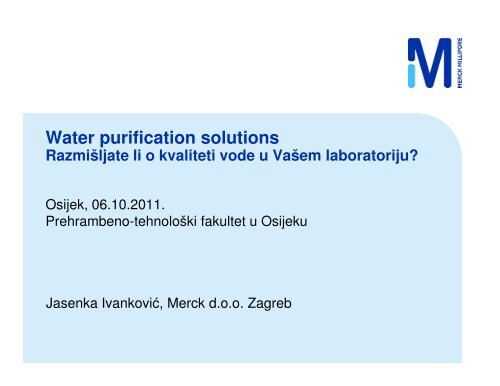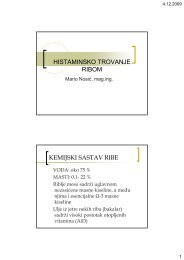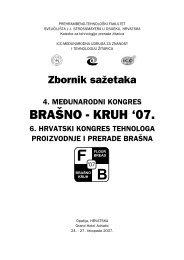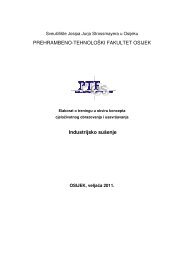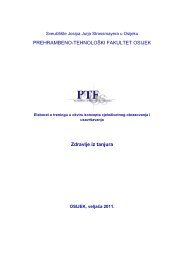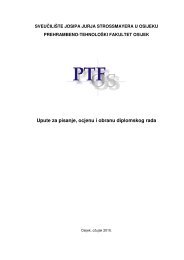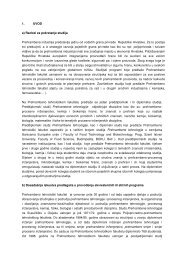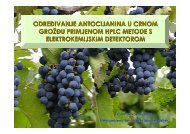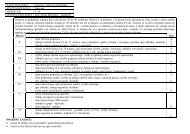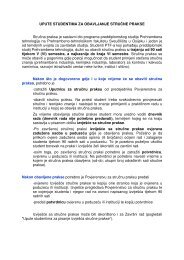Water purification solutions - Prehrambeno-tehnološki fakultet Osijek
Water purification solutions - Prehrambeno-tehnološki fakultet Osijek
Water purification solutions - Prehrambeno-tehnološki fakultet Osijek
You also want an ePaper? Increase the reach of your titles
YUMPU automatically turns print PDFs into web optimized ePapers that Google loves.
<strong>Water</strong> <strong>purification</strong> <strong>solutions</strong><br />
Razmišljate li o kvaliteti vode u Vašem laboratoriju?<br />
<strong>Osijek</strong>, 06.10.2011.<br />
<strong>Prehrambeno</strong>-tehnološki <strong>fakultet</strong> u <strong>Osijek</strong>u<br />
Jasenka Ivanković, Merck d.o.o. Zagreb
Agenda<br />
- <strong>Water</strong> <strong>purification</strong> fundamentals<br />
- <strong>Water</strong> contaminants<br />
- Quality monitoring<br />
- Purification techniques<br />
- Standards and norms<br />
- Pure water production and storage, ultrapure water production<br />
Presentation title in footer | 00 Month 0000
Natural water sources<br />
Sea <strong>Water</strong> Iced <strong>Water</strong> Ground <strong>Water</strong><br />
Lake <strong>Water</strong> Swamp <strong>Water</strong> River <strong>Water</strong><br />
Presentation title in footer | 00 Month 0000
<strong>Water</strong> contaminants groups<br />
+ - INORGANIC IONS<br />
ORGANICS<br />
PARTICLES / COLLOIDS<br />
MICROORGANISMS<br />
DISSOLVED<br />
GASES<br />
Presentation title in footer | 00 Month 0000
From natural water to pure & ultrapure water<br />
Natural water contains 5 main classes of contaminants<br />
These contaminants, if they may have negative effects on human<br />
health, are removed down to a safety level by <strong>Water</strong> Companies<br />
Potable tap water still contains some of these contaminants, at levels<br />
that are not harmful for humans<br />
However, even at that level, these contaminants can be detrimental to<br />
laboratory instruments & experimentations<br />
These contaminants should therefore be monitored and removed to<br />
acceptable levels by appropriate techniques.<br />
When their effect on experimentation is unknown, they should be<br />
removed as much as possible (precaution principle)<br />
Presentation title in footer | 00 Month 0000
<strong>Water</strong> <strong>purification</strong> techniques<br />
+ -<br />
Contaminants Removal By<br />
Still DI EDI RO UF MF AC UV 254<br />
185<br />
Presentation title in footer | 00 Month 0000
Distillation<br />
Benefits<br />
Limitations<br />
Removes a large percentage of<br />
all types of contaminants<br />
Produces water with resistivity<br />
between 0.2 and 1 MegOhm.cm @<br />
25°C and TOC between 50 and<br />
100 ppb<br />
Average investment<br />
Well known and perceived as<br />
easy to operate<br />
Not all contaminants are removed<br />
and several are generated during<br />
the process<br />
No control of water quality<br />
High operating costs due to<br />
electric heating (0.8KW/L) and<br />
water cooling (15 L tap water /L<br />
distilled water produced)<br />
Not ecologically friendly<br />
Regular maintenance (acid<br />
cleaning) or pretreatment (DI) is<br />
actually required to ensure<br />
optimum performance<br />
Presentation title in footer | 00 Month 0000
Deionization with single use mixed bed resin<br />
Benefits<br />
Effective at removing ions<br />
(Resistivity : 1 - 10 Megohm.cm<br />
with a single pass through the resin<br />
bed)<br />
Easy to use (simply open the tap<br />
and get the water)<br />
Limitations<br />
Does not eliminate particles,<br />
organic materials or<br />
microorganisms.<br />
Limited capacity depending on<br />
binding sites density and<br />
accessibility : requires good quality<br />
feed water to prevent premature<br />
exhaustion.<br />
Capacity related to flow rate<br />
Incorrect resin selection or<br />
multiple regeneration will cause<br />
water contamination by<br />
organic,particulate .<br />
Presentation title in footer | 00 Month 0000
Electrodeionisation (EDI)<br />
Benefit<br />
s<br />
Very efficient removal of ions and<br />
small MW charged organics (R> 5<br />
MegOhm.cm @ 25°C)<br />
Low energy consumption<br />
High water recovery<br />
Low operating cost<br />
Low maintenance<br />
No particulates or organic<br />
contamination (smooth, continuous<br />
regeneration by weak electric<br />
current)<br />
Moderate investment<br />
Limitations<br />
Requires good quality (RO) feed<br />
water to prevent plugging<br />
(particulates), fouling (organic,<br />
colloids) of ion-exchange resin<br />
beads.<br />
Solution required to prevent<br />
scaling at the cathode (early solution<br />
= softener)<br />
CO2 not totally removed if at high<br />
level in feed water.<br />
Presentation title in footer | 00 Month 0000
Reverse Osmosis<br />
Benefits<br />
Removes a fair percentage of all<br />
types of water contaminants (ions,<br />
organics, pyrogens, viruses,<br />
bacteria, particulates, colloids)<br />
Low operating costs due to low<br />
energy needs<br />
No need for strong acid and<br />
bases cleaning ; minimum<br />
maintenance<br />
Good control of operating<br />
parameters.<br />
<strong>Water</strong> consumption 2 to 10 times<br />
lower than stills (recovery up to<br />
66%) .<br />
Presentation title in footer | 00 Month 0000<br />
Limitations<br />
Not enough contaminants are<br />
removed to satisfy Type II<br />
requirements.<br />
Reverse Osmosis membranes<br />
are subject to plugging<br />
(particulates), fouling<br />
(organic,colloids), piercing (particle,<br />
chemical attack) and scaling<br />
(CaCO3) in the long run if not<br />
properly protected
Ultrafiltration<br />
Benefits<br />
Effective removal (>90%) of all<br />
organic molecules with molecular<br />
weight above the NMWL. Very<br />
efficient at removing pyrogens and<br />
Rnases (if validated) and viruses<br />
as well as particles.<br />
No risk of scaling ; limited risk of<br />
fouling.<br />
Low use of water and energy<br />
Low maintenance ; procedures<br />
well documented / accepted.<br />
Limitations<br />
Almost no rejection of ions, gases<br />
and low molecular weight organics<br />
(tightest UF membranes have a<br />
1,000 dalton cut-off<br />
BioPak<br />
Presentation title in footer | 00 Month 0000
Membrane (Screen) Microfiltration<br />
Benefits<br />
100 % removal of all<br />
contaminants (particulates,<br />
bacteria)larger than pore size.<br />
Integrity test available<br />
Sterilizing filtration (0.22 um<br />
membranes - LRV > 7)<br />
Minimum maintenance : simply<br />
replace when required.<br />
High flow rates are achievable at<br />
low pressure<br />
Efficiency independent of flow<br />
rate.<br />
Limitations<br />
Minimum effect on other<br />
contaminants<br />
Surface retention : may be<br />
subject to fouling/ plugging<br />
Presentation title in footer | 00 Month 0000
Activated Carbon<br />
Benefits<br />
Effective removal of a large<br />
range of organic substances (even<br />
of low molecular weight) by non<br />
specific binding (Van der Waals<br />
forces) or chlorine reduction<br />
Large capacity due to high<br />
developed surface<br />
Limitations<br />
Very little effect on other<br />
contaminants (except some<br />
particulates removed by depth<br />
filtration)<br />
Once all active sites are<br />
occupied, an equilibrium is<br />
established and organics are<br />
released.<br />
Bacteria may develop after<br />
several months.<br />
Efficiency depending on flow rate<br />
Presentation title in footer | 00 Month 0000
UV Technology (185 + 254 nm)<br />
Benefits<br />
Conversion of traces of organic<br />
contaminants to charged species<br />
and ultimately CO2 (185 + 254)<br />
Limited destruction of microorganisms<br />
and viruses (254)<br />
Limited energy use<br />
Easy to operate<br />
Limitations<br />
Polishing technique only: may be<br />
overwhelmed if organics<br />
concentration in feed water is too<br />
high<br />
Organics are converted, not<br />
removed.<br />
Limited effect on other<br />
contaminants<br />
Good design required for<br />
optimum performance.<br />
Presentation title in footer | 00 Month 0000
Technologies & Contaminants Removal<br />
IONS<br />
ORGANICS<br />
PARTICLE<br />
COLLOIDS<br />
BACTERIA<br />
GASES<br />
STILL DI RO UF MF AC UV<br />
Contaminant still 100% present (not removed)<br />
Contaminant completely (100%) removed
Main water purity criteria – resistivity and TOC<br />
Presentation title in footer | 00 Month 0000
Conductivity / resistivity measurement<br />
Conductivity and resistivity used to define the overall ionic purity/contamination<br />
Conductivity<br />
X = F∑c i z i µ i<br />
Conductivity<br />
(Siemens/cm)<br />
Faraday<br />
constant<br />
Concentration of each ionic<br />
species (eq/ml)<br />
Valence<br />
Mobility<br />
Ω -1 .cm -1 .s -1<br />
[H + ] = [OH - ] = 10 -7 M<br />
Minimum theoretical conductivity is<br />
0.055 µS.cm -1 at 25 °C<br />
Resistivity<br />
R<br />
=<br />
1<br />
X<br />
Maximum theoretical<br />
resistivity is 18.2 MΩ.cm at 25 °C<br />
Presentation title in footer | 00 Month 0000
Ultrapure water resistivity = f (t °C)<br />
18.2<br />
Resistivity (MΩ.cm)<br />
100<br />
90<br />
80<br />
70<br />
60<br />
50<br />
40<br />
30<br />
20<br />
10<br />
0<br />
Presentation title in footer | 00 Month 0000<br />
It is important to notify the temperature at<br />
which conductivity or resistivity<br />
measures are performed as those values<br />
are strongly dependent on temperature.<br />
At 25°C, ultrapure water<br />
resistivity = 18.2 MΩ.cm<br />
0 20 40 60 80 100 120<br />
25°C<br />
At 10°C, ultrapure water<br />
resistivity = 43.4MΩ.cm<br />
Temperature (°C)
Millipore resistivity meter: a unique design<br />
Electrodes<br />
Support<br />
block<br />
Thermistor<br />
Concentric electrodes design<br />
ensures reproducible manufacturing<br />
and stable cell constant.<br />
No dead legs: immediate response<br />
Made of high quality 316 L stainless<br />
steel<br />
Low cell constant<br />
(0.01 cm -1) for accuracy<br />
Protected thermistor<br />
Thermistor sensitivity = 0.1 °C<br />
Electronic autotest<br />
Alarms if defective parts<br />
Presentation title in footer | 00 Month 0000
Millipore Built-in Resistivity Meters<br />
Design allows to perform suitability test as<br />
required by USP (§ 645)<br />
Resistivity meter calibrated with traceability<br />
to internationally recognized primary<br />
standards<br />
Concentric electrodes design for cell<br />
constant stability<br />
Patented cell design<br />
US Patent Number:<br />
0405347000<br />
<br />
low cell constant (0.01 cm-1)<br />
Delivered with certificate of calibration<br />
Presentation title in footer | 00 Month 0000
Why TOC ? Because no correlation between<br />
resistivity & TOC level in ultrapure water<br />
+ sugar Monitoring<br />
Municipal tap<br />
water<br />
Polishing<br />
Reverse<br />
Storage<br />
Unit<br />
osmosis<br />
reservoir<br />
No UV<br />
20<br />
1200<br />
High purity<br />
water<br />
Resistivity, megohm.cm<br />
18<br />
16<br />
14<br />
12<br />
10<br />
8<br />
0<br />
0 30 60 90 120 150 180 210 240<br />
Time, minutes<br />
1000<br />
800<br />
600<br />
400<br />
200<br />
TOC, ppb<br />
Presentation title in footer | 00 Month 0000
Organics detection by TOC Monitor<br />
Built-in calibrated TOC Monitor<br />
TOC USP suitability testing: USP < 643><br />
Presentation title in footer | 00 Month 0000
TOC Monitor – Calibration Certificate - 1<br />
Presentation title in footer | 00 Month 0000
Conclusion<br />
We have reviewed 2 water analytical methods that are well adapted to<br />
measure the ABSENCE of specific contaminants types in ultrapure<br />
water<br />
Resistivity measure allows to ensure on-line and in real time that ionic<br />
contamination of ultrapure water is below 1 µg/L level<br />
TOC measure allows to ensure that organic contamination is below the<br />
5 µg/L level<br />
Both methods, in order to deliver significant results, require:<br />
Proper design : adequate measure + alarms if defective measure<br />
Proper calibration<br />
Respect of established norms<br />
Merck Millipore meters meet those criteria and deliver therefore valid<br />
assurance of water quality<br />
Presentation title in footer | 00 Month 0000
Laboratory grade water norms<br />
Different laboratory water grades have been defined by different regulatory<br />
bodies: ASTM, ISO, USP, CLSI, CAP…<br />
The grades correspond to both applications & specifications<br />
Their role is both technical & economical<br />
- Technical: select the adequate water quality for a specific application<br />
- Economical: avoid selecting a quality that is too high for an application as<br />
the cost of laboratory grade water production increases with the water<br />
quality<br />
Presentation title in footer | 00 Month 0000
<strong>Water</strong> Quality Specifications<br />
Contaminant Parameter & unit Type 1 Type 2 Type 3<br />
Ions<br />
Resistivity<br />
(M Ω .cm)<br />
> 18.0 > 1.0 > 0.05<br />
Organics TOC (ppb) < 10 < 50 < 200<br />
Particulates Particulates > 0.2<br />
< 1 NA NA<br />
µm (units / ml)<br />
Silica Silica (ppb) < 10 < 100 < 1000<br />
Bacteria Bacteria (cfu/ml) < 0.1 < 100 < 1000<br />
Type 1 water<br />
HPLC and IC mobile phase preparation; blanks and sample dilution in GC, HPLC, AA , ICP-MS and<br />
other advanced analytical techniques ; preparation of buffers and culture media for mammalian cell<br />
culture, IVF, reagents for molecular biology...<br />
Complies with ASTM Type 1, ISO 3696 Grade 1, Pharmacopeiea
Type 3 water - basic laboratory applications<br />
<strong>Water</strong> baths<br />
Rotavapors<br />
Presentation title in footer | 00 Month 0000<br />
Autoclaves
Type 2 water - regular laboratory applications<br />
Titrators<br />
Presentation title in footer | 00 Month 0000<br />
pH Meters<br />
Regular lab<br />
<strong>solutions</strong> such<br />
as buffers<br />
Glassware<br />
Washers
Type 1 water - critical laboratory applications<br />
Molecular<br />
Biology<br />
Elemental<br />
Trace Analysis<br />
Cell Culture<br />
HPLC<br />
Presentation title in footer | 00 Month 0000
Production of Pure <strong>Water</strong><br />
Type 3 and Type 2
Тype 3 water - pure water - RiOs systems<br />
Technologies: Pretreatment + Reverse Osmosis (+ UV optional)<br />
Systems: RiOs (3,5,8 and16 l/h) and Large RiOs (30, 50, 100, 150 and 200 l/h)<br />
Applications:<br />
Type 3 Laboratory-grade water is used in laboratories mainly for non-critical<br />
applications such as:<br />
- Glassware rinsing<br />
- Feed water for humidifiers, autoclaves, washing machines<br />
- Feed water for Milli-Q ultrapure water systems
RiOs principles<br />
Conductivity<br />
cells<br />
Optional<br />
on-line UV Lamp<br />
(254 nm)<br />
Storage<br />
Reservoir<br />
Pump<br />
MILLIPORE<br />
Tap<br />
<strong>Water</strong><br />
Type 3<br />
<strong>Water</strong><br />
1. Progard<br />
pretreatment pack to<br />
protect the RO<br />
membrane:<br />
• Activated Carbon<br />
(+ silver) against<br />
chlorine<br />
• Polyphosphate<br />
against scaling<br />
• Depth Filter against<br />
particulates<br />
Recovery<br />
Loop<br />
RO Reject<br />
Drain<br />
2. RO Cartridge<br />
(including sanitization<br />
port):<br />
Removes all types of<br />
contaminants up to<br />
98% (except gasses)<br />
Tank<br />
Point Of Use
Type 2 <strong>Water</strong> Systems & Applications<br />
Technologies:<br />
• Pretreatment<br />
• RO<br />
• EDI or DI<br />
• UV<br />
Type 2 <strong>Water</strong> Systems:<br />
• Elix 3, 5,10,15, 20,35,70,100<br />
• RiOs-DI 3 UV<br />
Applications:<br />
• Microbiology Media preparation<br />
• Feed to clinical analyzers<br />
• Chemical reactions run in water<br />
• Weatherometers<br />
• Washing machines<br />
• Histology<br />
• Feed to Ultrapure (Type 1) Milli-Q water<br />
systems
Electro - deionization (Elix technology)<br />
EDI module<br />
- Ion selective membranes<br />
- Ion exchange resins<br />
- Continuous current<br />
RO water 10-20µS<br />
A C A C<br />
Anode<br />
+<br />
OH -<br />
H +<br />
Na<br />
+<br />
Cl -<br />
Cl - Cl -<br />
Na+<br />
H + OH -<br />
Cl -<br />
Cl - Na +<br />
Na+ -<br />
Cathode<br />
Reject<br />
A - Anionic Membrane<br />
C - Cationic Membrane<br />
Product<br />
Resistivity: > 10 MOhm.cm<br />
TOC: < 30 ppb
ELIX <strong>Water</strong> System Principles<br />
Conductivity<br />
cells<br />
Optional on-line<br />
UV Lamp (254 nm)<br />
Storage<br />
Reservoir<br />
Pump<br />
Resistivity<br />
cell<br />
MILLIPORE<br />
Tap<br />
<strong>Water</strong><br />
Type 3<br />
Type 2<br />
<strong>Water</strong><br />
<strong>Water</strong><br />
1.Progard<br />
pretreatment pack to<br />
protect the RO<br />
membrane:<br />
• Activated Carbon (+<br />
silver) against<br />
chlorine<br />
• Polyphosphate<br />
against scaling<br />
• Depth Filter against<br />
particulates<br />
Recovery<br />
Loop<br />
RO Reject<br />
Drain<br />
2. RO Cartridge<br />
(including sanitization<br />
port):<br />
Removes all types of<br />
contaminants up to<br />
98% (except gasses)<br />
EDI Reject<br />
3. EDI Module<br />
Removes remaining<br />
ions & small charged<br />
organic molecules <br />
5 < R < 15 MΩ.cm<br />
Type 2<br />
Point Of Use
ELIX Advantage System Principles On-line UV<br />
Lamp (254 nm)<br />
Storage<br />
Reservoir<br />
MILLIPORE<br />
Tap<br />
<strong>Water</strong><br />
Type 3<br />
<strong>Water</strong><br />
Type 2<br />
<strong>Water</strong><br />
Recovery<br />
Loop<br />
Drain<br />
Recirculation<br />
Loop<br />
POD-Pak<br />
E-POD
2- ELIX E-POD<br />
Feature<br />
E-POD = Elix water Point Of Delivery<br />
Benefits for User<br />
1. Improved bacterial water quality<br />
ᅳ<br />
ᅳ<br />
ᅳ<br />
Less than 0.1 cfu/mL (with final filter)<br />
Recirculation on UV light 254 nm<br />
Recirculation up to the point of use – POU (no dead volume)<br />
2. Ergonomic design & ease of use<br />
ᅳ<br />
ᅳ<br />
ᅳ<br />
ᅳ<br />
ᅳ<br />
Pressurized Type 2 water dispensing up to 2L/min<br />
Adapted for manual rinsing as well as vessel filling<br />
Volumetric dispensing available & easily accessible<br />
Monitoring at a glance on the POD screen (quality, volume…)<br />
Printing Function<br />
3. Versatility for multiple applications or users<br />
ᅳ<br />
ᅳ<br />
ᅳ<br />
POD-Paks = several POU filters available for specific quality<br />
Up to 3 E-PODs connected to the same system<br />
No need to carry water around anymore!
Storage and distribution - Types 3 & 2 (pure) water<br />
Best practices for laboratory water storage
The storage challenge<br />
Your needs<br />
The options you have<br />
What is this<br />
water used for?<br />
Any quality<br />
requirements?<br />
How much<br />
water do<br />
you need,<br />
when?<br />
Do you need<br />
to distribute<br />
the water to a bench,<br />
an instrument? etc<br />
1.Size of reservoir and of system<br />
2. Right storage solution to<br />
maintain the best quality<br />
3. Options to get pure water<br />
where and when you need it
Small Storage Reservoir offer
Summary: Storage & Distribution Good Practices<br />
Intermittent recirculation<br />
while limiting temperature<br />
build up<br />
Recirculation Loop.<br />
UV 254 nm Lamp in<br />
the Tank (ASM)<br />
Sanitary overflow +<br />
vent filter.<br />
Conical bottom tank for<br />
complete emptying<br />
Maintains water quality during<br />
non-use periods.<br />
Avoids stagnation and maintains<br />
water quality.<br />
Prevents biofilm formation<br />
Reduces need for chemical<br />
sanitisation<br />
Introduction of clean filtered air<br />
during drawoff of water.<br />
Easy to clean
Production of ultrapure water – Type 1
Ultrapure water adapted to each application<br />
Tap water<br />
Pure water – Type 3 or 2<br />
Pretreatment step<br />
Polishing step<br />
Ultrapure water – Type 1<br />
Nuclease-free<br />
water<br />
<strong>Water</strong> for trace<br />
ion analysis<br />
<strong>Water</strong> for<br />
organic analysis<br />
Low bacteria<br />
water
STANDBY<br />
READY<br />
°C<br />
M Ω.cm@ Ω<br />
25°C<br />
ΩΩ<br />
ppb TO C<br />
L<br />
STANDBY<br />
READY<br />
°C<br />
M Ω.cm@ Ω<br />
25°C<br />
ΩΩ<br />
ppb TO C<br />
L<br />
STANDBY<br />
READY<br />
°C<br />
M Ω.cm@ Ω<br />
25°C<br />
ΩΩ<br />
ppb TO C<br />
L<br />
New Concept<br />
Several water<br />
qualities<br />
One central <strong>purification</strong> unit and several<br />
point-of-use purifiers<br />
Screen filter<br />
Ultrafilter<br />
Activated<br />
Carbon<br />
Standard high<br />
purity water<br />
<strong>Water</strong> with no bacteria<br />
by-products (endotoxins,<br />
nucleases, …)<br />
<strong>Water</strong> with very low<br />
volatile organic<br />
pollutants
Q-POD Dispenser<br />
The most critical<br />
<strong>purification</strong> step<br />
for the user<br />
application comes<br />
last
POD-Pak polishers for any application
Type 1 <strong>Water</strong> Systems and Applications<br />
Type 1 <strong>Water</strong> Systems:<br />
– Milli-Q Integral (with TOC monitor)<br />
– Milli-Q Direct (with TOC indicator)<br />
– Direct-Q 3 UV<br />
– Milli-Q Advantage A10 (with TOC monitor)<br />
Applications:<br />
– HPLC and IC mobile phase preparation<br />
– Blanks and sample dilution in GC,<br />
HPLC, AA , ICP-MS and other advanced<br />
analytical techniques<br />
– Preparation of buffers and culture media<br />
– Preparation of buffers and culture media<br />
for mammalian cell culture, IVF,<br />
reagents for molecular biology
Gradient profiles - water with various TOC levels<br />
20 ppb<br />
13 ppb<br />
9 ppb<br />
5 ppb<br />
2 ppb<br />
Increasing TOC<br />
levels result in<br />
more extraneous<br />
peaks and shifts<br />
of the baseline<br />
Important to<br />
know what’s<br />
the TOC level<br />
of the water<br />
you use in your<br />
mobile phase !
<strong>Water</strong> contaminants:<br />
Summary of effects on HPLC performance<br />
Contaminants<br />
Effects on HPLC<br />
Improper check valve operation<br />
Particles<br />
Damage to pump and injector<br />
Plugging of frits and column<br />
Organics<br />
Ions<br />
Bacteria<br />
Ghost peaks<br />
Increased background noise<br />
Drifting baselines<br />
Some ions absorb in the UV range (e.g., NO 3- , NO 2- )<br />
With MS detectors: Na + , K + adduct peaks<br />
Plugging of frits and columns<br />
Ghost peaks
Summary of ISO 11131-1 :<br />
Type 2 water quality recommended for microbiology<br />
media preparation<br />
Since 99% of the culture media is water, water quality is critical. It should<br />
be:<br />
– free of nutrients<br />
– free of toxic substances<br />
– resistivity > 0.3 MΩ.cm (< 10 µS/cm)<br />
– low concentration of chlorine<br />
– low concentration of heavy metals<br />
– low microbial count
<strong>Water</strong> systems designed to serve your needs
Questions ?


